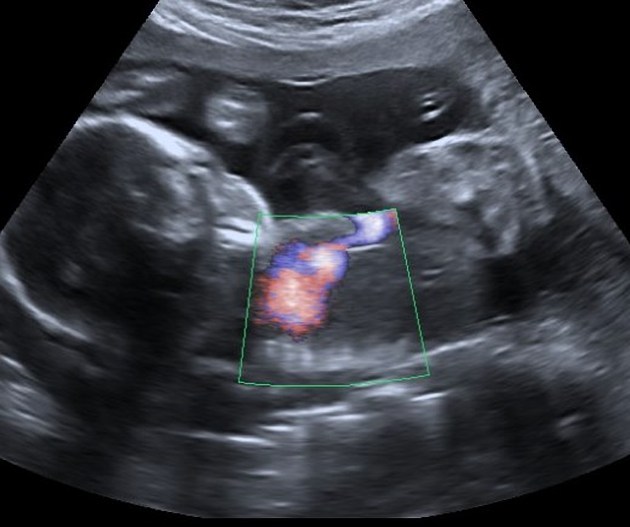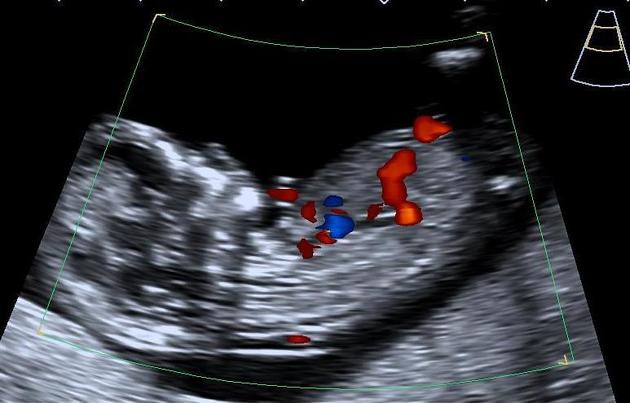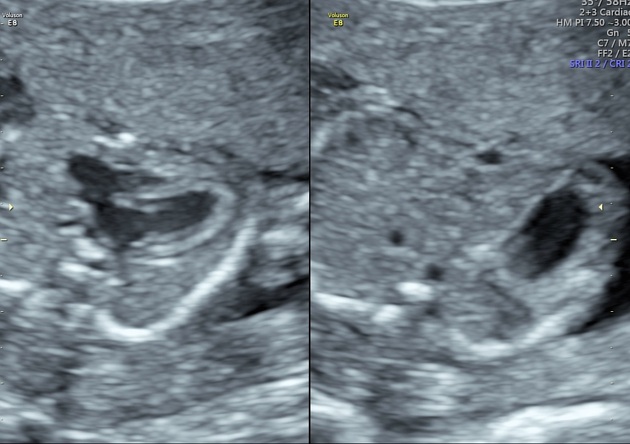Citation, DOI, disclosures and article data
Citation:
Weerakkody Y, Rasuli B, Sheikh Y, et al. Absent ductus venosus. Reference article, Radiopaedia.org (Accessed on 17 Feb 2025) https://doi.org/10.53347/rID-13833
Agenesis of the ductus venosus (ADV) is a rare fetal vascular anomaly.
According to the data obtained from the screening tests performed at 11-14 weeks of pregnancy, its incidence is reported to be 1/2500 12.
In a large case series, Acherman et al. 13 defined five drainage patterns in absent ductus venosus:
- the umbilical vein is connected to the systemic venous circulation through the portal sinus
- via an abnormal venous channel from the portal sinus to the right atrium
- presumably via hepatic sinusoids to the hepatic veins
- the umbilical vein bypasses the portal sinus and the liver and connects to the systemic venous circulation via an abnormal venous channel (case 2)
- from the umbilical vein to the right atrium, directly or through a dilated coronary sinus: considered the most common type 5 and carries the worst prognosis due to the risk of developing congestive cardiac failure 11
- from the umbilical vein to the midportion of the inferior vena cava (IVC)
- from the umbilical vein to the right iliac vein (case 1)
Associations
Treatment and prognosis
The prognosis of fetuses with absent ductus venosus diagnosed at 11-13 weeks of gestation depends on the measurement of nuchal translucency thickness, being poor if the thickness is increased and good if it is normal 12.
-
1. Perles Z, Nir A, Nadjari M et-al. Absent ductus venosus in the fetus: review of the literature and first report of direct umbilical venous drainage to the coronary sinus. Fetal. Diagn. Ther. 18 (4): 247-51. doi:10.1159/000070804 - Pubmed citation
-
2. Hoppen T, Hofstaetter C, Plath H et-al. Agenesis of the ductus venosus and its correlation to hydrops fetalis. J Perinat Med. 2000;28 (1): 69-73. doi:10.1515/JPM.2000.010 - Pubmed citation
-
3. Sivén M, Ley D, Hägerstrand I et-al. Agenesis of the ductus venosus and its correlation to hydrops fetalis and the fetal hepatic circulation: case reports and review of the literature. Pediatr Pathol Lab Med. 15 (1): 39-50. - Pubmed citation
-
4. Volpe P, Marasini M, Caruso G et-al. Prenatal diagnosis of ductus venosus agenesis and its association with cytogenetic/congenital anomalies. Prenat. Diagn. 2002;22 (11): 995-1000. doi:10.1002/pd.456 - Pubmed citation
-
5. Contratti G, Banzi C, Ghi T et-al. Absence of the ductus venosus: report of 10 new cases and review of the literature. Ultrasound Obstet Gynecol. 2001;18 (6): 605-9. doi:10.1046/j.0960-7692.2001.00599.x - Pubmed citation
-
6. Hofstaetter C, Plath H, Hansmann M. Prenatal diagnosis of abnormalities of the fetal venous system. Ultrasound Obstet Gynecol. 2000;15 (3): 231-41. doi:10.1046/j.1469-0705.2000.00066.x - Pubmed citation
-
7. Sau A, Sharland G, Simpson J. Agenesis of the ductus venosus associated with direct umbilical venous return into the heart--case series and review of literature. Prenat. Diagn. 2004;24 (6): 418-23. doi:10.1002/pd.882 - Pubmed citation
-
8. Jaeggi ET, Fouron JC, Hornberger LK et-al. Agenesis of the ductus venosus that is associated with extrahepatic umbilical vein drainage: prenatal features and clinical outcome. Am. J. Obstet. Gynecol. 2002;187 (4): 1031-7. Am. J. Obstet. Gynecol. (link) - Pubmed citation
-
9. Berg C, Kamil D, Geipel A et-al. Absence of ductus venosus-importance of umbilical venous drainage site. Ultrasound Obstet Gynecol. 2006;28 (3): 275-81. doi:10.1002/uog.2811 - Pubmed citation
-
10. Takeuchi M, Nakayama M, Tamura A et-al. Hydrops fetalis due to agenesis of the ductus venosus: new hepatic histological features. Pediatr. Dev. Pathol. 12 (3): 239-43. doi:10.2350/07-10-0363.1 - Pubmed citation
-
11. Sothinathan U, Pollina E, Huggon I et-al. Absence of the ductus venosus. Acta Paediatr. 2006;95 (5): 620-1. doi:10.1080/08035250500477560 - Pubmed citation
-
12. Staboulidou I, Pereira S, de Jesus Cruz J, Syngelaki A, Nicolaides K. Prevalence and Outcome of Absence of Ductus Venosus at 11+0 to 13+6 Weeks. Fetal Diagn Ther. 2011;30(1):35-40. doi:10.1159/000323593 - Pubmed
-
13. Acherman RJ, Evans WN, Galindo A, Collazos JC, Rothman A, Mayman GA, Luna CF, Rollins R, Kip KT, Berthody DP,Restrepo H. Diagnosis of absent ductus venosus in a population referred for fetal echocardiography: Association with a persistent portosystemic shunt requiring postnatal device occlusion. J Ultrasound Med. 2007 Aug;26(8):1077-82.
Promoted articles (advertising)







 Unable to process the form. Check for errors and try again.
Unable to process the form. Check for errors and try again.